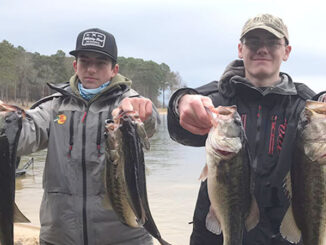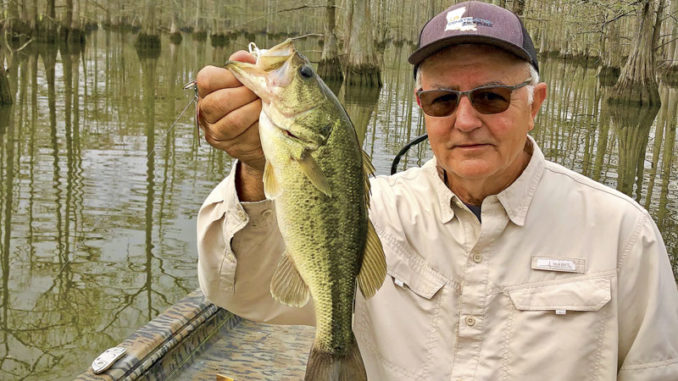
“Lurking in the shadows” has a kind of sinister, evil sound to it. But it doesn’t have to, especially when you are talking about finding largemouth bass in early summer. In fact, you might just find the shadows a great spot to find your Happy Place on the lake.
Bass love the shadows — under piers and boat docks, grass mats and lily pads, cypress tree canopies, even the shady side of stumps and the like. If it casts a shadow and it is in decent water, it can hold summer bass. Knowing that and concentrating on finding a pattern around the “dark side’ can help you catch more bass this month.
“The water temperature in our lakes and bayous surface can easily reach the mid-90’s in the summer. Many bass drop down close to the thermocline where they can enjoy cooler temperatures and still have oxygenated water. However, some bass never leave shallow water. They find cooler water under protective cover like pads, docks, or trees,” said avid West Monroe angler Mike Wood.
Wood also knows a little bit more than your average angler when it comes to bass habits. He worked his entire career as a biologist with the Louisiana Department of Wildlife and Fisheries, including his final stint as the Director of Inland Fisheries for the group. Today, he owns and manages Mike Wood Services, specializing in the management of freshwater systems and working with everything from small backyard ponds to large multi-purpose impoundments.
He runs all sorts of tests and population studies on these lakes and that also often includes “Cast and reel” studies, where you chunk a bait all day and see what you can catch. It’s a tough job, but somebody’s got to do it.
Scientific journey
Recently, I went along on such a “scientific journey” with him and helped him cast and reel. And catch. This particular lake was overpopulated with one and two pound bass and we removed some of them, all in the name of science, you know.
But one of the things we talked about and experimented with was casting to fish in the shadows.
“When it’s hot, I fish shaded shorelines,” Wood said. “The fish seem to be more active and I know it feels better to me. I stay shallow most of the time and cover water pretty fast with a spinnerbait.”
Wood likes to throw the spinnerbait up as tight to cover as he can, get the blades moving immediately and let it slowly fall to the desired depth on a steady retrieve. If he is fishing an object, he’ll pitch it past the shadow and make sure the bait is close to structure in the shadow on the retrieve. The fish usually hit in the shadow or just as the bait starts to leave the shadow in the water. That’s because many times the fish are staging looking for an easy meal on the edge. It may take them a few feet to catch up to the bait.
“I also throw a worm into spots that look like they need it,” he said. “Later in the day, I like to skip weightless plastic baits way under docks and back into places that are hard for other folks to get a bait to.”
One way he does that is a technique where he picks up a spinning rod and skips the bait as far back under the cover, like a boat dock, as he can. He works the worm slowly and tries not to make a big splash because he said that can spook the fish.
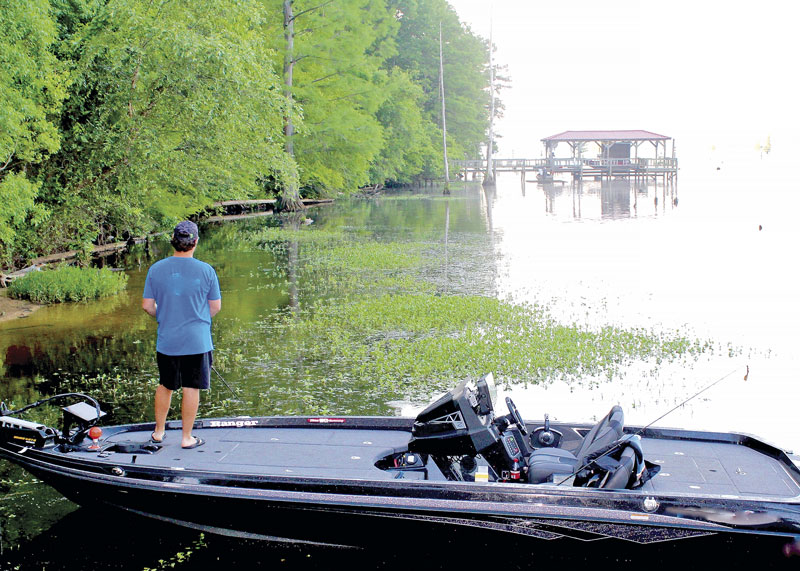
No special trick
While fish sometimes lay on the bottom, the majority of fish hiding out in shallow water are suspended, especially under grass mats or around boat dock piers.
“Bass have an air bladder very similar to a scuba diver’s BCD (buoyancy control device),” Wood said. While a person would have a hard time hanging out three feet deep in six feet of water, it’s no special trick for bass.
“Divers are taught to put in just enough air to become weightless,” Wood said. “Bass do it naturally, so they can hover at any depth as long as they want to.”
To get the complete picture, I’ll have to get all scientific on you. There are two kinds of shadows. First is the Umbra, the darkest part of a shadow where light sources are completely blocked. It’s almost like night. The second is Penumbra, where only a portion of the light source is blocked. That’s the best spot to fish shadows. However, you can still catch fish in complete darkness, like night fishing.
Fish depend on their lateral line that functions to detect vibrations from food and predators. The line also allows fish to orientate themselves in a water current.
Slightly cooler water in the shadows helps keep bass there. And it’s important to remember that since bass don’t have eyelids, they are extremely light sensitive. So the only way for them to escape the sun is to hide in vegetation or in the shadows.
Think about these six types of spots and don’t pass them up in your summer fishing.
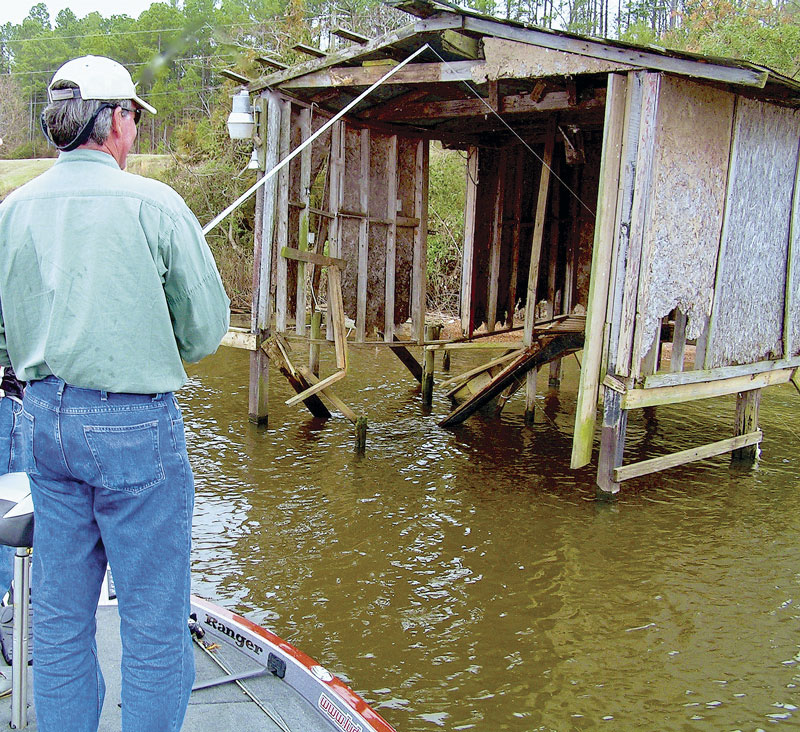
Boat docks and bridges
Boat docks are perhaps the best spots to look for shade-happy bass. Most every lake has lots of them and they offer varied structure. The key is to fish every inch of the docks, and often make multiple casts at pilings and cross timbers until you establish a pattern. Also probe the depths of the water under the dock, trying to reach spots that other anglers might miss.
Remember bass can be anywhere under the dock, so try it all. The same goes for bridges. Fish the pilings and the shadows. Logjams, grassbeds and other structure in combination with docks and bridges are bed and breakfast spots for bass. Fish slow and methodically until you feel like you know where the fish are located. The odds are they will be on the same places and in the same depths on similar structure that day. Remember, yesterday’s pattern may not work today. A bonus hint: Bass seem to like the old wood best. New docks aren’t as likely to hold bass as the old ones.
Marinas and pontoon boats
Marinas usually offer lots of posts and pylons and floating docks, all casting shadows that bass can hide out in. Fish them just like the boat docks, trying different angles and presentations.
Pontoon boats are usually left in the water and are not on lifts, so work them hard. Each pontoon plus the boat itself offers cover.
Find areas where there is not a lot of activity. You won’t catch as many by the ramp where anglers are constantly putting boats in and out. And if there is a fish-cleaning station or drain, work those hard. Look for something different.
Cypress trees
Every cypress tree casts a shadow and if you fish them this time of the year, fish the dark side. When the wind is blowing, remember the fish may be positioned facing into the waves looking for an easy meal, while staying in the shade for comfort. When you combine those two elements, it’s a double bonus.
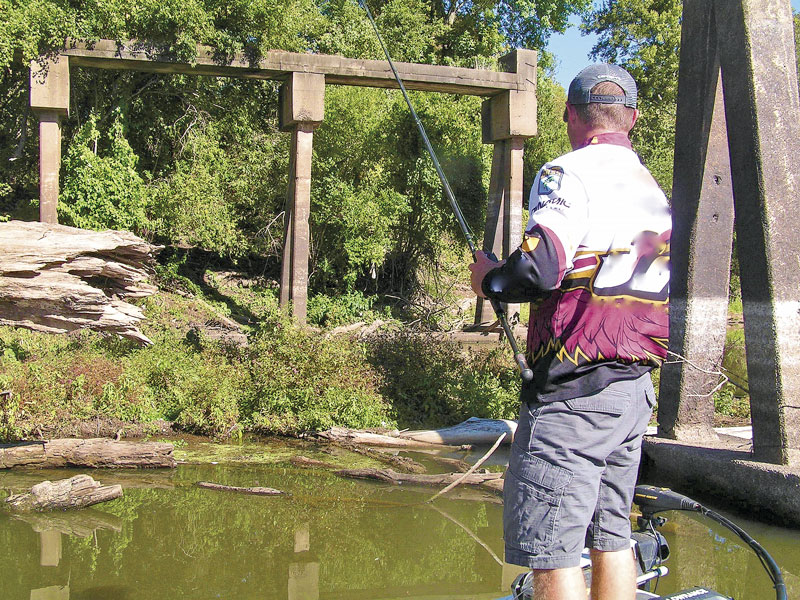
Also pattern fish here just like docks. If you catch a couple on the six-foot deep trees or the two-foot deep trees, stick with what the bass are telling you.
Leaning logs and big stumps
A big old leaning log not only casts a shadow, it’s an excellent ambush point for bass. You won’t find a lot of those in most lakes, but it’s worth a short trip on the trolling motor to check one out if you spot one. Cast across it and let your bait drop down, then cast parallel with the log on both sides and work the entire length.
Big stumps also cast big shadows. Fish the shadow side of big stumps and try lures that work at different depths from the top to the bottom.
Lily pad fields
Fishing a lily pad field offers so many options it’s a hard choice of where to pitch your lure. Start on the edge, look for irregular pockets or openings in the pads and when you can, toss a lure like a frog way back in the pads, stopping it in any open areas. There are no better “shadow spots” than the pads.
Single pads located a few feet away from the big field can also hold bass. Don’t pass them up. Again, look for something different and when you catch a fish, look for areas just like the one that fish came from.
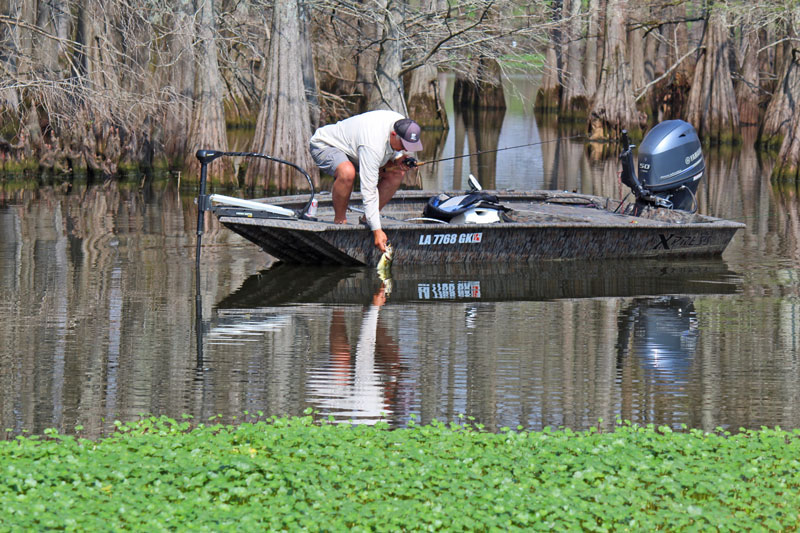
Grass mats
Thick mats of grass not only offer shade, they hide baitfish and offer perhaps the coolest water on the lake in the summer. Fish the edges of the grass and if you are fishing by yourself, make casts parallel to the beds.
In shallower water, keep a heavy jig or a creature bait with a big weight tied on. If you can find spots to punch the bait through, it’s an excellent way to get to big bass hiding beyond where you can cast a bait. Fish the most healthy aquatic vegetation. It has the best oxygen and nutrients.
Bass help
One more thing about Wood and his business that helps people manage their lakes and ponds.
“In my consulting business, I deal with all issues related to lake management,” he said. “Folks that own small lakes usually know when they have a problem, but they aren’t sure how to address those problems without making things worse. I provide solutions without a sales pitch. I don’t sell stuff. My product is technical guidance. I’ve found that people really appreciate recommendations that are only made in the best interest of them and their waters.”
You can reach him at mikewoodfisheries.com.


